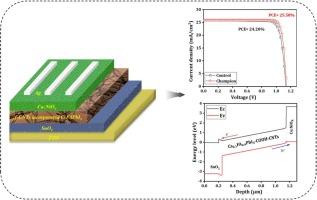揭示铯掺杂和功能化碳纳米管对CsxFA1-xPbI3性能的影响:来自SCAPS-1D模拟的见解
IF 6
2区 工程技术
Q2 ENERGY & FUELS
引用次数: 0
摘要
为了提高钙钛矿太阳能电池(PSCs)的相稳定性和光电性能,人们广泛探索铯(Cs)掺入钙钛矿碘化铅(FAPbI3)中。本研究采用模拟驱动的优化方法来评估不同Cs掺杂(5%、10%和15%)和功能化碳纳米管(f-CNTs)对fapbi3基钙钛矿太阳能电池光伏性能的影响。在所测试的组合物中,Cs0.1FA0.9PbI3 (10% Cs掺杂)是最佳组合物。由于带隙调谐、相位稳定和缺陷钝化的理想平衡,它实现了最高的功率转换效率(PCE)。除了调整成分外,还将原始碳纳米管和f-碳纳米管掺入到Cs0.1FA0.9PbI3钙钛矿吸收层(PAL)中,以进一步提高PCE。一项对原始碳纳米管、羧基(- cooh)功能化碳纳米管和胺基(- nh2)功能化碳纳米管的比较模拟研究表明,COOH-CNTs具有优越的电荷传输性能,有效抑制重组损失并显著提高效率。优化后的PSC结构FTO/SnO2/Cs0.1FA0.9PbI3-COOH-CNTs/Cu:NiOx/Ag的PCE为25.58%,开路电压(Voc)为1.14 V,短路电流密度(Jsc)为25.93 mA/cm2,填充系数(FF)为86.26%。这些结果强调了f-CNTs在增强电荷分离方面的关键作用,并为下一代高性能钙钛矿光伏发电提供了一条有希望的途径。本文章由计算机程序翻译,如有差异,请以英文原文为准。

Unveiling the impact of cesium doping and functionalized carbon nanotubes on CsxFA1-xPbI3 performance: Insights from SCAPS-1D simulations
The incorporation of cesium (Cs) into formamidinium lead iodide (FAPbI3) is widely explored to enhance the phase stability and optoelectronic properties of perovskite solar cells (PSCs). This study employs a simulation-driven optimization approach to evaluate the effects of varying Cs doping (5%, 10%, and 15%) and functionalized carbon nanotubes (f-CNTs) on the photovoltaic performance of FAPbI3-based perovskite solar cells. Among the compositions tested, Cs0.1FA0.9PbI3 (10% Cs doping) emerges as the optimal composition. It achieves the highest power conversion efficiency (PCE) owing to the ideal balance of bandgap tuning, phase stabilization, and defect passivation. In addition to compositional tuning, pristine and f-CNTs are incorporated into the Cs0.1FA0.9PbI3 perovskite absorber layer (PAL) to enhance the PCE further. A comparative simulation study of pristine, carboxyl (–COOH)- functionalized, and amine (–NH2)- functionalized CNTs shows that COOH-CNTs deliver superior charge transport properties, effectively suppress recombination losses and significantly boost efficiency. The optimized PSC configuration FTO/SnO2/Cs0.1FA0.9PbI3-COOH-CNTs/Cu:NiOx/Ag achieves an impressive PCE of 25.58%, with an open-circuit voltage (Voc) of 1.14 V, a short-circuit current density (Jsc) of 25.93 mA/cm2, and a fill factor (FF) of 86.26%. These results underscore the crucial role of f-CNTs in enhancing charge separation and offer a promising route for next-generation high-performance perovskite photovoltaics.
求助全文
通过发布文献求助,成功后即可免费获取论文全文。
去求助
来源期刊

Solar Energy
工程技术-能源与燃料
CiteScore
13.90
自引率
9.00%
发文量
0
审稿时长
47 days
期刊介绍:
Solar Energy welcomes manuscripts presenting information not previously published in journals on any aspect of solar energy research, development, application, measurement or policy. The term "solar energy" in this context includes the indirect uses such as wind energy and biomass
 求助内容:
求助内容: 应助结果提醒方式:
应助结果提醒方式:


